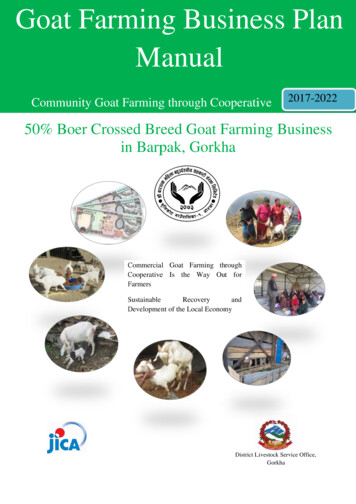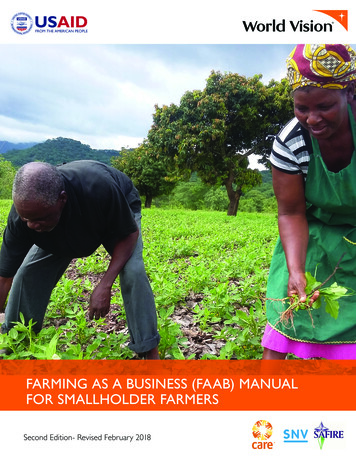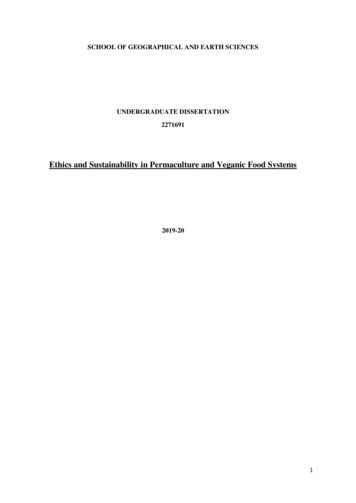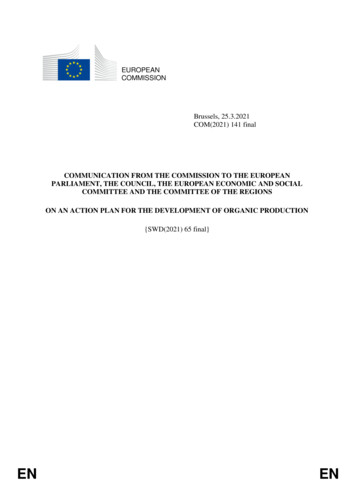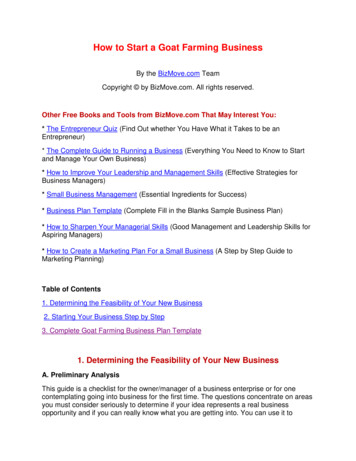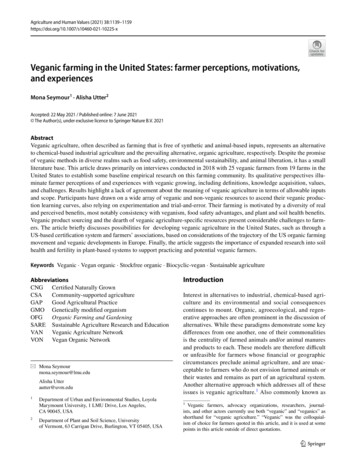
Transcription
Agriculture and Human Values (2021) 0225-xVeganic farming in the United States: farmer perceptions, motivations,and experiencesMona Seymour1 · Alisha Utter2Accepted: 22 May 2021 / Published online: 7 June 2021 The Author(s), under exclusive licence to Springer Nature B.V. 2021AbstractVeganic agriculture, often described as farming that is free of synthetic and animal-based inputs, represents an alternativeto chemical-based industrial agriculture and the prevailing alternative, organic agriculture, respectively. Despite the promiseof veganic methods in diverse realms such as food safety, environmental sustainability, and animal liberation, it has a smallliterature base. This article draws primarily on interviews conducted in 2018 with 25 veganic farmers from 19 farms in theUnited States to establish some baseline empirical research on this farming community. Its qualitative perspectives illuminate farmer perceptions of and experiences with veganic growing, including definitions, knowledge acquisition, values,and challenges. Results highlight a lack of agreement about the meaning of veganic agriculture in terms of allowable inputsand scope. Participants have drawn on a wide array of veganic and non-veganic resources to ascend their veganic production learning curves, also relying on experimentation and trial-and-error. Their farming is motivated by a diversity of realand perceived benefits, most notably consistency with veganism, food safety advantages, and plant and soil health benefits.Veganic product sourcing and the dearth of veganic agriculture-specific resources present considerable challenges to farmers. The article briefly discusses possibilities for developing veganic agriculture in the United States, such as through aUS-based certification system and farmers’ associations, based on considerations of the trajectory of the US organic farmingmovement and veganic developments in Europe. Finally, the article suggests the importance of expanded research into soilhealth and fertility in plant-based systems to support practicing and potential veganic farmers.Keywords Veganic · Vegan organic · Stockfree organic · Biocyclic-vegan · Sustainable agricultureAbbreviationsCNG Certified Naturally GrownCSA Community-supported agricultureGAP Good Agricultural PracticeGMO Genetically modified organismOFG Organic Farming and GardeningSARE Sustainable Agriculture Research and EducationVAN Veganic Agriculture NetworkVON Vegan Organic Network* Mona Seymourmona.seymour@lmu.eduAlisha Utterautter@uvm.edu12Department of Urban and Environmental Studies, LoyolaMarymount University, 1 LMU Drive, Los Angeles,CA 90045, USADepartment of Plant and Soil Science, Universityof Vermont, 63 Carrigan Drive, Burlington, VT 05405, USAIntroductionInterest in alternatives to industrial, chemical-based agriculture and its environmental and social consequencescontinues to mount. Organic, agroecological, and regenerative approaches are often prominent in the discussion ofalternatives. While these paradigms demonstrate some keydifferences from one another, one of their commonalitiesis the centrality of farmed animals and/or animal manuresand products to each. These models are therefore difficultor unfeasible for farmers whose financial or geographiccircumstances preclude animal agriculture, and are unacceptable to farmers who do not envision farmed animals ortheir wastes and remains as part of an agricultural system.Another alternative approach which addresses all of theseissues is veganic agriculture.1 Also commonly known as1Veganic farmers, advocacy organizations, researchers, journalists, and other actors currently use both “veganic” and “veganics” asshorthand for “veganic agriculture.” “Veganic” was the colloquialism of choice for farmers quoted in this article, and it is used at somepoints in this article outside of direct quotations.13Vol.:(0123456789)
1140vegan organic or stockfree organic agriculture outside ofNorth America, veganic production excludes animal farming and the use of animal-based inputs while also eschewingsynthetic inputs.The Veganic Agriculture Network (VAN), a core promoter in North America, describes veganic agriculture as“an approach to growing plant foods that encompasses arespect for animals, the environment, and human health. this is a form of agriculture that goes further than organicstandards, by eliminating the use of products that are derivedfrom confined animals and by encouraging the presence ofwild native animals on the farmland” (2014). The VeganOrganic Network (VON), a key supporting body based in theUnited Kingdom, explains that “‘Veganic’ is a combinationof two words ‘vegan’ and ‘organic’. It’s a guarantee that foodis grown in an organic way with only plant based fertilizers, encouraging functional biodiversity so pesticides are notnecessary. No chemicals, no [genetically modified organisms(GMO)] and no animal byproducts in any part of the chain”(n.d.-a). VAN elaborates that veganic agriculture avoids animal-derived products such as manure, blood meal, feathermeal, and fish emulsion. Instead, it implements plant-basedfertility sources such as mulches, composts, green manures,crop rotation, and other sustainable techniques that do notrely on animal exploitation, and may also incorporate mineral supplements. Ideals also include: reducing dependenceon fossil fuels; producing fertility on-site; building the soilto feed the plants and create long-term fertility; replenishingplant and animal biodiversity; and fostering the wild ecologyon and around the farmland (Veganic Agriculture Network2014, 2016).Veganic is best regarded as a set of guiding principlesfor farming and gardening rather than as a distinct technique unto itself. A number of approaches to agricultureare veganic in their nature (particularly with respect to thefertility component) or quite close to it, including the RuthStout technique, the biointensive approach developed byJohn Jeavons, and Shumei Natural Agriculture (VeganicAgriculture Network n.d.). The vegan organic approach promoted by VON has been codified into a set of farming standards known as the Stockfree Organic Standards2 (est. 2007)(Vegan Organic Network n.d.-b). Biocyclic vegan agriculture represents another approach to veganic cultivation andis described as “purely plant-based organic farming” which“excludes all commercial livestock farming and slaughtering of animals and does not use any inputs of animal origin.M. Seymour, A. UtterSpecial emphasis is placed on the promotion of biodiversity, healthy soil life, the closure of organic cycles and onsystematic humus build-up” (Adolf Hoops Society n.d.-a).The corresponding Biocyclic-Vegan Standards (est. 2017)are available to farmers worldwide (Adolf Hoops Societyn.d.-a).There are a number of other approaches that are compatible with veganic principles, but are typically not practicedveganically. These include container gardening, field-scaleagriculture, no-till agriculture, and permaculture (VeganicAgriculture Network n.d.; Veganic Agriculture Network2016). For instance, container gardeners may seek outchemical- and manure-free potting soil and make their ownplant-based compost (Veganic Agriculture Network 2011a;Veganic Agriculture Network 2013a). Vegan permaculture isan approach to permaculture design that omits domesticatedanimals from the system, while designing with free-livinganimals in mind (Veganic Agriculture Network 2013b).Veganic principles can also be observed in communitieswithout access to synthetic inputs and animal products. Forinstance, some horticultural societies did not keep domesticated animals and thus had no readily available source ofmanure (Richerson et al. 1996; Mt. Pleasant 2011). TheMesoamerican milpa, integrating beans, corn, and squash,is an example of an indigenous cropping system historicallyfree of chemical and domesticated animal inputs (Nobari2021).Academic and practitioner literature has favorably associated veganic approaches with various agronomic factors,including: yield, quality, nutrient cycling, soil nitrogen level,soil carbon storage, soil biology, soil organic matter, andenergy inputs (Pimentel et al. 2005; Cormack 2006; Hepperly et al. 2006; Eisenbach et al. 2018; Matsuura et al. 2018;Eisenbach et al. 2019; Roussis et al. 2019; Rosato et al.2020; Utter and Seymour forthcoming)3; sustainable agriculture or food systems (Hall and Tolhurst 2007; Visak 2007;Burnett 2014; Bonsall 2015; Hagemann and Potthast 2015;Hirth 2020; Kassam and Kassam 2021; Nobari 2021); foodsafety (O’Brien 1964; Seymour 2018a; Alsanius et al. 2019;Utter and Seymour forthcoming); diminished environmentalimpacts (Markussen et al. 2014; Seymour 2018a); marketingpotential (Jürkenbeck et al. 2019; Jürkenbeck and Spiller2020); and “animal-friendly” (Visak 2007) and “post-lethal”(Mann 2020) agriculture. Despite the diversity of veganic32“Stockfree” was selected as a “more neutral technical term,” notnecessarily associated with veganism (Schmutz and Foresi 2017, p.477). The term is not entirely a neutral one, though, as it connotesthat animals are not a necessary component to horticulture and diets(Schmutz and Foresi 2017).13Several of these references reflect field trials with a known veganiccomponent—identified in Cormack (2006) as “truly stockless,” orverified through personal correspondence. There are a number ofadditional field trials around the world that Watson et al. (2006) identify as including a “stockless” rotation. The term stockless refers tofarms with no livestock (or with a very low livestock to land ratio),but does not necessarily mean that those farms exclude all inputsfrom animals (i.e., are “stockfree”) (Schmutz and Foresi 2017).
Veganic farming in the United States: farmer perceptions, motivations, and experiences methods and the ostensible benefits of veganic agriculture,there is relatively little scholarly literature on the topic, ashas been noted by Hagemann and Potthast (2015), Schmutzand Foresi (2017), and Jürkenbeck et al. (2019). Qualitativeperspectives are particularly lacking. The intention of thisarticle is to illuminate some of the human dimensions ofveganic agriculture, with attention to the practitioners, values, and experiences of veganic farming in the United States.It is guided by the following research questions: How do USveganic farmers define veganic agriculture? Why and howhave they adopted veganic practices? What challenges havethese farmers encountered in practicing veganic agriculture?The article first reviews peer-reviewed qualitative literature on veganic agriculture, and then considers howscholarship on the US organic agriculture movement mightshed light on the above research questions. It then explainsthe methods for the present study and describes researchparticipants and their farms. The subsequent section presents results on participants’ conceptualizations of veganicfarming, veganic learning processes, perceived benefits ofveganic farming, and veganic farming challenges. Finally,the discussion considers implications of these findings,drawing on the US organic farming experience and veganicfarming in Europe; and suggests further avenues of researchinto veganic agriculture.Literature reviewAs mentioned above, while “veganic” is the most common term in English-speaking North America, other worldregions have alternative terminology, and there are alsonumerous methods that are veganic but not identified inname as such. With these factors in mind, a search wasconducted for literature germane to farmer experiences inveganic, vegan organic, stockfree organic, and biocyclicvegan methods. A small number of sources were found thatdescribe farmer motivations for, understandings of, andchallenges of veganic growing. One case study of a veganicfarm in the United States indicates that the owner-operatorschose to practice veganic agriculture to align their organiccertified operation with their recent personal transition toveganism (Seymour forthcoming). Another case study of avegan organic farm in the United Kingdom suggests that theformer cattle farmers transitioned to veganic agriculture outof care and concern for animal welfare, food security, andthe environmental and climate impacts of cattle production(Hirth 2020). Schmutz and Foresi reported on a small German-language study of vegan organic growers’ motivationsfor excluding animal inputs, which found ethical, social,and ecological motives for this practice, suggesting that itis an “idealistic” approach (2017, p. 476). Another Germanstudy links farmer motivations with love for animals and1141the appeal of not killing animals in a veganic system. Participants agreed that neither animal products nor livestockwere part of veganic agriculture. The same study suggestsa number of challenges for vegan organic farmers, including with “plant-based soil and plant nutrition, weed control,pests and diseases, soil structure and economy” as well aswith ensuring good yields and developing fertilizer alternatives (Bonzheim et al. 2015).Thus, the existing veganic literature offers little insightinto farmer perceptions of and experiences with veganicagriculture. Several experienced veganic and organic farmers in and beyond this study have suggested that veganicfarming in the US may currently be where the US organicmovement was in the range of 30–50 years ago (Seymour,personal communications, 2017–2018). Obach writes that“In the United States of the early 1970s, organic farmingwas an obscure agricultural practice carried out by a smallnumber of counterculture farmers and a smattering of commercial producers who recognized that there was somethingwrong with the dominant industrial food model. Few in thegeneral public were familiar with the term organic, andfewer still had ever purchased an organic product. The smallhandful of scholars and university-based scientists interestedin alternatives to the industrial agriculture model were marginalized by their peers. Organic practices were not recognized by the federal government, and food industry scientistsdismissed organic methods as a hoax ” (2015, p. 6). Thesmall number of farms, low levels of consumer awarenessand academic interest, and lack of federal recognition oforganic agriculture approximately 50 years ago appear toparallel the status of veganic agriculture in the United Statestoday. Thus, literature on early US organic farmers’ experiences (c.late 1960s/early 1970s) may offer some generalinsight on present-day veganic farmers’ definitions, valueorientations, learning approaches, and challenges.While a comprehensive review of that literature is beyondthis paper’s scope, some potentially helpful ideas emergefrom key texts. For instance, Obach has noted that the meaning of organic and the particular practices defining organichave long been deliberated and contended. However, priorto a pressing need for organic certification, “defining organicwas an informal dialogic process” amongst an informal network of practitioners and ideological leaders (2015, p. 44).A fundamental shared view that organic farming excludedsynthetic chemicals prevailed in the mid-twentieth century.As the movement began to develop a more structured organizational form in the 1970s, and once organic advocatessought to codify and regulate their practices with an eyeto developing the organic market, the challenge of formaldefinition arose (Obach 2015).Motivations in the established US organic community ofthe 1950s and 1960s were diverse. Organic farming pioneerJ.I. Rodale maintained that chemical fertilizers and poison13
1142sprays obliterated soil life, thus leading to the production of“unhealthy plants and animals which when eaten produceunhealthy people” (Rodale 1948, p. 199). Another organicproponent, Paul Keene, linked organic agriculture to socialjustice, environmental protection, health, and equity (Slighand Cierpka 2007). Novelist and organic farmer Louis Bromfield pursued “the romantic agrarian ideal of a ‘Jeffersonian Republic’: small, organic farms as ‘cells’ of a sustainablesociety” (Vogt 2007, p. 26). While during this time there wasa commercial organic element oriented toward private profit,“Organic proponents had a mission; they sought to transformthe way agriculture was done” (Obach 2015, p. 39). Thesefarmers challenged the growing dominance of corporate andindustrialized agriculture (Sligh and Cierpka 2007).During this time period, farmers learned to build organicsystems from experience and from other farmers, including their publications. The Rodale Press was a major sourceof practical information (Francis and Van Wart 2009). Itsjournal Organic Farming and Gardening (OFG, est. 1942),served as the primary connector of organic producers in theUS for the next couple of decades and as “the central vehiclefor spreading organic ideology and practice” (Obach 2015,p. 38). OFG had a small readership until it was picked up bythe counterculture in the late 1960s (Belasco 2007).In the late 1960s, a “new wave of activist farmers”entered organic farming (Reed 2010, p. 89). This “influx ofcountercultural radicals” who would dominate the organicmovement in the coming years arrived with a variety of critiques (Obach 2015, p. 42). “Young farmers wishing not to‘sell out’ to the industrial-military complex chose organicfarming, as did those who saw no role for government inagriculture or were concerned about the growing threats ofcorporate agribusiness” (Sligh and Cierpka 2007, p. 33).Some sought radical social transformation via communalprojects, and others looked toward “simpler agriculturalexistence along with a social order reminiscent of the agrarian Jeffersonian ideal,” yet common ground existed in widespread rejection of industrial technologies and embrace of“organic practices as a natural alternative to a food systemincreasingly dominated by corporations and dependent onsynthetic pesticides and fertilizers” (Obach 2015, p. 41). AsGuthman summarized, “A generation of growers entered intoorganic production because of deeply held political, environmental, philosophical, and/or spiritual values. Many cameout of the counterculture or were influenced by environmental ideas in their college years and decided to try their luck atfarming. Some followed the writings of the philosophical orpractical giants in sustainable agriculture (e.g., Wes Jacksonand Robert Rodale, respectively) and deliberately made theeffort to put these written ideas into practice. Others wereless circumspect and simply felt that organic agriculturewas somehow ‘the right thing to do’. Whether they ‘alwayshave been and always will be’ organic growers or whether13M. Seymour, A. Utterthey converted to organic farming out of clear conviction Before the 1980s, they were virtually the only growers topopulate the organic sector” (2014, p. 23).Also during this period, some conventional farmers hadbegun to regard organic farming as a means to be fairlycompensated in the face of low commodity prices and asa way to avoid toxic chemical exposure (Sligh and Cierpka2007). Research on Midwestern organic grain and livestockfarmers, most of whom had converted from conventionalto organic methods in their commercial farming operationsaround 1971, suggests that concerns about chemical usewere paramount (Lockeretz et al. 1981). These includedthe health implications of agricultural chemicals for theirlivestock or family, soil problems, or the ineffectiveness ofchemicals. General dislike of chemicals, concern about theenvironment, and religious principles were among thosereported less frequently as reasons for transitioning. Lockeretz et al. concluded that their sample was motivated toadopt organic farming more by pragmatic considerationsthan by philosophical or ideological ones (1981).Lockeretz et al. also reported some challenges experienced by Midwestern organic converts. Most important wasthe difficulty in finding markets for organic products, followed by: weed problems; the low opinion of organic farming held by others; and acquiring information about organicpractices (Lockeretz et al. 1981; Lockeretz and Madden1987). Other farmers attempting organic cultivation similarly recalled the lack of university courses and of extensionsupport: “And if you called up the extension with a question like, ‘how do you do organic raspberries?’ they wouldlaugh at you” (Obach 2015, p. 55). Lack of organic farming knowledge resulted in the decline in the number of newcountercultural communes devoted to organic farming in theearly 1970s. The labor-intensity of some organic methodsalso emerged as a barrier to success (Belasco 2007).Responses to challenges and deficits continued to materialize. Some collectives developed labor-saving approachesto pest control, composting, and other organic practices(Belasco 2007). Throughout the broader organic community, farmer-led experimentation and technology development improved techniques and practices (Parr et al. 1983).On-farm apprenticeship opportunities emerged as a moreformal educational resource, such as that established at theUniversity of California at Santa Cruz in 1970; this programwas key in the diffusion of organic farming (Sriskandarajahet al. 2006; Guthman 2014). The organic farmers’ associations that began to develop in the 1970s effected informationexchange, including via facilitating farmer-to-farmer connections for problem-solving; sponsoring meetings and fieldtrips; and publishing newsletters (Parr et al. 1983; Obach2015).Though “the grand social vision of the 1960s’ radicals faded” (Obach 2015, p. 215), many organic farmers
Veganic farming in the United States: farmer perceptions, motivations, and experiences remained committed to transforming the food system, andsome joined efforts to formalize and self-regulate via theorganic farmers’ associations and certification programsthat emerged in the early 1970s (Sligh and Cierpka 2007;Guthman 2014; Obach 2015). In the late 1970s and 1980s,developments such as increased public concern about theenvironmental and health effects of industrial farming,changes in food culture, and the farm crisis led to the expansion of organic production (Guthman 2014; Obach 2015). Inparticular, conventional-to-organic converts “with arguablymore tepid motivations” swelled the ranks of organic farmers (Guthman 2014, p. 42).The above contributions begin to shed some light onactual and possible values and experiences of veganicfarmers. Small studies from the United States and Europefound that veganic farmers: may have some consensus onthe basic principles of veganic agriculture; are motivatedby personal ethics and social and ecological values; and facea variety of agronomic challenges and information needs.Yet the experiences of US organic farmers in the 1960s and1970s suggest that contemporary veganic farmers may stillbe shaping the meaning of veganic and lack consensus onits practices. Adoption of organic farming during this periodencompassed a variety of reasons, including philosophical,political, and safety-related motives; the initial absence ofpervasive financial motivation for organic farming is notable. Many of the barriers faced by organic farmers relatedto agronomic production, public perception, marketing,labor intensity, and information deficits. Learning organicproduction and surmounting its challenges were addressedthrough independent and collaborative experimentation andinnovation, as well as growers’ association and Universityresources.There are apparent gaps in knowledge about the USveganic farming experience. The dearth of qualitative literature that explores the human dimensions of a potentiallysustainable, safe, and ethical approach to agriculture is amajor impetus for this article.MethodsRecruitmentPotential participants were identified using an online map ofUS veganic farms (Seymour 2018b). This resource includedall veganic operations known to its author, who compiledmap data via extensive web searches and communicationswith farmers. When recruitment began in January 2018,56 farms were represented on the map. The study’s sampling frame included farms that sold any dollar amount ofproduce, and omitted hydroponic farms and non-diversified farms given the study’s scope; it comprised 44 farms.1143Recruitment efforts began with a focus on eligible farms in"veganic hotspot" regions of the United States—the Westcoast and the Northeast. Over the first half of 2018, recruitment broadened to other regions and additional farms toincrease participation. A total of 39 veganic farms across thecountry were targeted. Farmers were contacted up to threetimes via email, social media, and/or telephone with invitations to participate. This stage of contact included basicinformation about the study’s purpose, goals, and surveyand interview methods; and the offer of a 25 stipend forcompleting the entire study. Nineteen farms completed participation in the study. Two additional farms completed thesurvey but did not participate in the interview.SurveyThe online platform KoBoToolbox was used to build anddeploy a pre-interview survey to collect information aboutthe farms and their owners or operators. The survey linkwas disseminated via email. After giving informed consent,respondents were prompted to complete around 35 questions on basic farm information (e.g., acreage, products),farm financials, and respondent demographics. Survey datawere collected between February and July 2018 for 21 farms(Table 1). Of the 19 farms that completed participation inthe study, all had ten acres or fewer under cultivation, andmost (74%) were growing on two acres or less. A majority (84%) grossed under 40,000 in 2017, with about half(47%) grossing under 10,000, though six respondents indicated that these amounts were less than anticipated due tolower productivity than expected that year, personal or family health problems, or other issues. In 2018, only one ofthe 19 fully participating farms held a veganic certification(the Stockfree certification), about a quarter (26%) held anorganic or similar certification, and over half (58%) had nocertification, though two were in transition. Most (79%) offull participant farms utilized direct marketing methods, particularly community-supported agriculture (CSA) programsand farmers’ markets. All farms produced at least some vegetables, which was commonly reported as the most profitablecrop type, with many also growing berries, tree fruits, herbs,and/or flowers.InterviewInterviews were conducted between March and July 2018with 25 participants representing 19 farms. In five cases,a farm manager or co-owner/operator joined the surveyrespondent for the interview. In one case, the recent former owner and the new owner of the same farm wereinterviewed (separately). At least four respondents operated their farms with a partner who was not present atthe interview. Interviews were completed in-person by13
Year farm wasestablished (yearfarm becameveganic)1989 (2013)2015 (2015)2005 (2014)2011 (2011)2015 in currentlocation (2015)Early twentiethcentury, by family; reestablished2014 (2014)Farm identificationnumber and location, by US Censusregion—divisionFarm 1PacificFarm 2PacificFarm 3PacificFarm 4PacificFarm 5PacificFarm 6PacificTable 1 Farm characteristics131Acreage undercultivation, 2017In transition toorganic certificationCertified organicYear-round0.5 (inclusive ofmultiple production sites)Leased (owned bynon-householdfamily eNoneSeasonalSeasonalSeasonal v. year- Certifications atround production time of studyOwnedOwned0.25Other (owned bynon-householdfamily member,used without alease)1.5 (Inclusive ofLeased; Other(informal arrange- multiple production sites)ment)OwnedLand ownership,2017Direct marketing(farmers’ market); Wholesalemarketing (restaurant)Direct marketing(CSA, farmers’market)Under 1000a 20,000–29,999Under 1000a 20,000–29,999 10,000- 19,999a 2,500–4,999aMarketing channels Gross farm income,(most profitable in 2017bold)Vegetables, berries, Direct marketing (farmers’tree fruits, herbs,market)plant starts and/or nursery plants,value-addedproductsDirect marketingVegetables, ber(CSA, farmer’sries, tree fruits,market, farmflowers, herbs,stand or store,nuts and/or seeds,farm website);value-addedWholesaleproductsmarketing (retailmarkets)Direct marketVegetables, treeing (farmers’fruits, nuts and/market, other);or seedsWholesalemarketing (retailmarkets)Direct marketingVegetables, ber(CSA, farmers’ries, tree fruits,market, farmstandflowers, herbs,or store); Wholemushrooms, nutssale marketingand/or seeds,(food hub orplant starts and/orvalue-added pronursery plantsducer, restaurant,retail markets)VegetablesVegetables, berries, herbsProducts (mostprofitable in bold)1144M. Seymour, A. Utter
OwnedOther (owned bynon-householdfamily member;use agreementunclear)2017 (2017)2016 (2016)2014 in currentlocation (2014)2010 (2010)2009 (2011)2012 (2012)1971 (1975)Not indicated(2010)Farm 8PacificFarm 9PacificNo IDbPacificFarm 10East North CentralFarm 11East North CentralFarm 12East North CentralFarm 13New EnglandFarm 14New EnglandOwnedLeasedOwnedOwnedLeasedLeasedOwnedNot indicated(2017)Farm 7PacificLand ownership,2017Year farm wasestablished (yearfarm becameveganic)Farm identificationnumber and location, by US Censusregion—divisionTable 1 (continued)Not indicatedSeasonalNot sonalSeasonalYear-roundProducts (mostprofitable in bold)NoneCertified organicVegetables, herbs, Vertical integration withplant starts and/orrestaurantnursery plantsNot indicated 2500–4999 30,000–39,999a 250,000–499,999c 1000–2499 2500–4999a 5000–9999Under 1000aNot indicatedMarketing channels Gross farm income,(most profitable in 2017bold)Vegetables, berries, Vertical integration withflowers, herbs,restaurantfield crops, smallgrains,nuts and/orseeds, plant startsand/or nurseryplantsDi
vegan organic or stockfree organic agriculture outside of North America, veganic production excludes animal farm-ing and the use of animal-based inputs while also eschewing synthetic inputs. The Veganic Agriculture Network (VAN), a core pro

